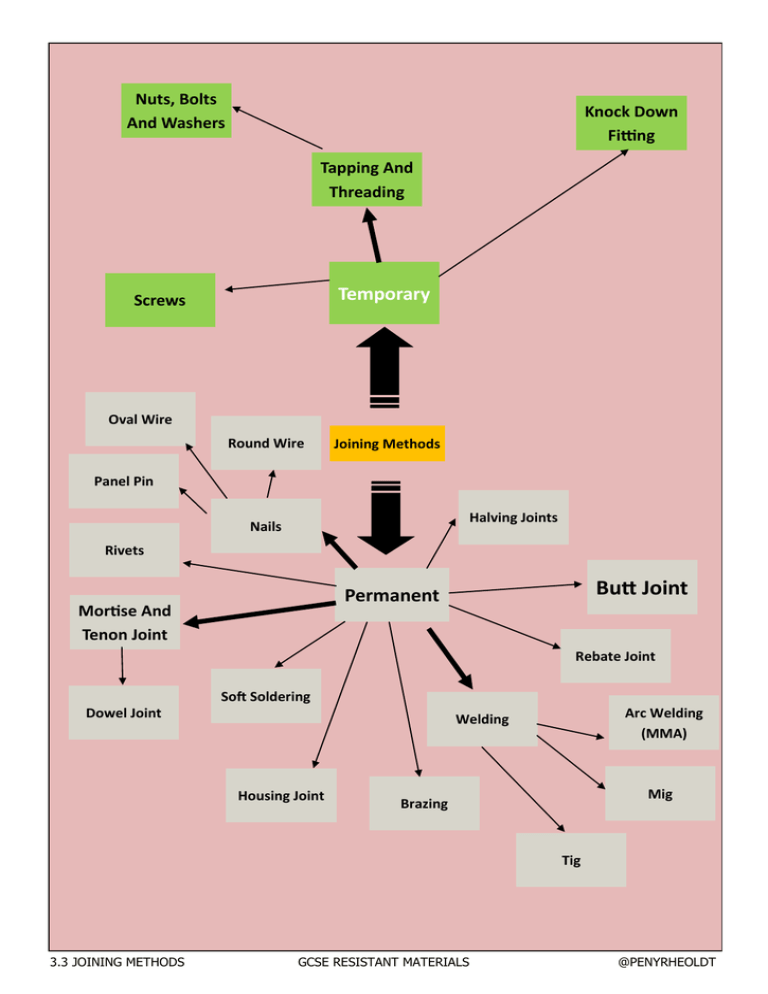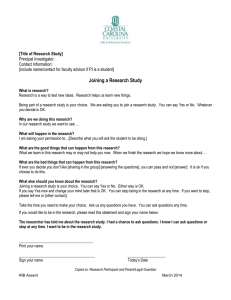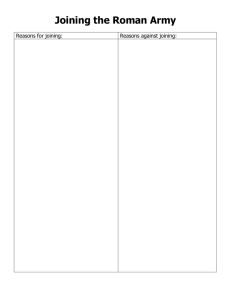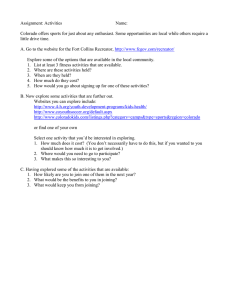Butt Joint
advertisement

Nuts, Bolts And Washers Knock Down Fitting Tapping And Threading Temporary Screws Oval Wire Round Wire Joining Methods Panel Pin Halving Joints Nails Rivets Butt Joint Permanent Mortise And Tenon Joint Rebate Joint Soft Soldering Dowel Joint Arc Welding (MMA) Welding Housing Joint Mig Brazing Tig 3.3 JOINING METHODS GCSE RESISTANT MATERIALS @PENYRHEOLDT JOINING METHODS FACTSHEET Temporary 3.3 JOINING METHODS GCSE RESISTANT MATERIALS @PENYRHEOLDT JOINING METHODS FACTSHEET Tapping And Threading Uses Advantages For creating thread either external or internal depending on application Allows bolts to be used where a temporary fixing may be required Can be used in plastic and metal Can be used to restore damaged threads Allows for nuts to be used as a temporary fixing if required Thread size can be varied by adjusting pinch bolts on the die stock Disadvantages If dies are not set square you will get a drunken thread Smaller sizes break easily if not used correctly Clogs up easily due to swarf build up Can be difficult to start 3.3 JOINING METHODS GCSE RESISTANT MATERIALS @PENYRHEOLDT JOINING METHODS FACTSHEET Nuts, Bolts And Washers Uses Advantages Nuts and bolts provide a temporary fixing and a convenient method of securing parts that can be easily be undone Can be undone so items can be taken apart Come in various lengths and sizes Lock nuts can be used for firm fixings Disadvantages Can work loose with vibration If correct size spanner is not used you can round the head Can become cross threaded damaging the threads 3.3 JOINING METHODS GCSE RESISTANT MATERIALS @PENYRHEOLDT JOINING METHODS FACTSHEET Screws Uses Advantages Screws offer a reliable and neat method of fixing wood metal and plastic. The can be removed making them a temporary but study. Can be easily removed Some new screw do not need pilot holes or clearances Can be used to joint dissimilar materials e.g. plastic to wood Disadvantages Steel screws will rust if outside Some screws can be hard to remove It is difficult to get screws out if the shear off If holes are not correctly prepared, screws can split material when inserted 3.3 JOINING METHODS GCSE RESISTANT MATERIALS @PENYRHEOLDT JOINING METHODS FACTSHEET Knock down fittings Uses Advantages There are many knock down joining methods, all of which allow joints to be made quickly and easily. Allows larger assembly to be transported Can be taken apart multiple times Parts interchangeable The parts can be taken apart easily and quickly, so the whole construction can be “knocked down” or flat packed for easy transportation Disadvantages Can some times make things unstable Not the greatest of weight bearing joint. 3.3 JOINING METHODS GCSE RESISTANT MATERIALS @PENYRHEOLDT JOINING METHODS FACTSHEET Permanent 3.3 JOINING METHODS GCSE RESISTANT MATERIALS @PENYRHEOLDT JOINING METHODS FACTSHEET Round Wire Nail Uses Advantages Nails are a quick method of joining wood. As nails are driven into wood, they grip by forcing the fibres of the wood away from the head. This makes them difficult to withdraw Big flat head makes it easy to hit Sometimes serrated which helps them grip A general Rule when using nails is nail length should be three times the width of the wood being joined Disadvantages Longer nails can bend when being hit 3.3 JOINING METHODS GCSE RESISTANT MATERIALS @PENYRHEOLDT JOINING METHODS FACTSHEET Oval Wire Nail Uses Advantages Nails are a quick method of joining wood. As nails are driven into wood, they grip by forcing the fibres of the wood away from the head. This makes them difficult to withdraw A general Rule when using nails is nail length should be three times the width of the wood being joined Can be punched below the surface and the hole filled Disadvantages Very difficult to get out as the head is below the surface 3.3 JOINING METHODS GCSE RESISTANT MATERIALS @PENYRHEOLDT JOINING METHODS FACTSHEET Panel Pin Uses Advantages Nails are a quick method of joining wood. As nails are driven into wood, they grip by forcing the fibres of the wood away from the head. This makes them difficult to withdraw A general Rule when using nails is nail length should be three times the width of the wood being joined Small heads can be punched below the surface with a nail punch Disadvantages Bend more easily due to their thinness 3.3 JOINING METHODS GCSE RESISTANT MATERIALS @PENYRHEOLDT JOINING METHODS FACTSHEET Wood Joints 3.3 JOINING METHODS GCSE RESISTANT MATERIALS @PENYRHEOLDT JOINING METHODS FACTSHEET Halving Joint Description Advantages Halving joints are made by cutting away half the thickness of the material on each half of the joint. Having joints can be used on corners, tees, or for cross halving. Stronger than butt joints Can be strengthened easily by adding dowels Disadvantages Accuracy must be maintained to archive a perfect finish 3.3 JOINING METHODS GCSE RESISTANT MATERIALS @PENYRHEOLDT JOINING METHODS FACTSHEET Butt Joint Description Advantages Butt joints are the simplest form of joint and the weakest since the only have a small gluing area, which means they can be pulled apart. They are used in cheap furniture and sometimes have dowels added to reinforce them. Cheap Most simple joint Can be strengthen relatively easily Disadvantages Weak due to small gluing area 3.3 JOINING METHODS GCSE RESISTANT MATERIALS @PENYRHEOLDT JOINING METHODS FACTSHEET Rebate Joints Description Advantages Rebate joints are also know as lap joints. One part of the two pieces being joined is left plain and the other has a rebate cut into it, which means that half the thickness of the material is removed to form a lip Stronger than a butt joint due to a larger gluing area and weight bearing lip Disadvantages Still potentially weak to certain forces 3.3 JOINING METHODS GCSE RESISTANT MATERIALS @PENYRHEOLDT JOINING METHODS FACTSHEET Housing Joint Description Advantages Housing joints can be cut in to natural timber and manufactured boards. They are commonly used in the constructions of cabinet work for shelves or dividers Provide a neat finish for shelves Weight bearing Disadvantages Difficult may be experienced in getting both sides exactly level for a shelf 3.3 JOINING METHODS GCSE RESISTANT MATERIALS @PENYRHEOLDT JOINING METHODS FACTSHEET Mortice and tenon joint Description Advantages Mortise and tenon joints are widely used in the construction of furniture frames. The mortise is marked out with a mortise gauge and cut with a mortise chisel. The width of the tenon should be one third the width of the timber. Strong Joint Neat Disadvantages If not accurately cut out the tenon may “float” creating an unstable frame. 3.3 JOINING METHODS GCSE RESISTANT MATERIALS @PENYRHEOLDT JOINING METHODS FACTSHEET Dowel joint Description Advantages Dowel joints are butt joints with dowels used as reinforcements. Dowels are made from beech or ramin. Holes are drilled in both pieces and glue is used to secure the dowels inn place and between the joining surfaces. Cheap reinforcement method Two or more dowels will prevent work pieces rotating if glue cannot be applied Disadvantages Relatively weak If holes are drill accurately the two mating surfaces will not match up 3.3 JOINING METHODS GCSE RESISTANT MATERIALS @PENYRHEOLDT JOINING METHODS FACTSHEET Metal Joints 3.3 JOINING METHODS GCSE RESISTANT MATERIALS @PENYRHEOLDT JOINING METHODS FACTSHEET Snap riveting Description Advantages Rivets are most commonly used in sheet metal, although they can also be used to join acrylic and some woods to metals. They are normally made from soft iron and are available with a range of heads, the most common being the countersunk or round head. This round head type of rivet is known as snap head rivet Can be drilled to undo joints Joints can be created as hinges Little specialist equipment required Disadvantages Can be time consuming when snap riveting 3.3 JOINING METHODS GCSE RESISTANT MATERIALS @PENYRHEOLDT JOINING METHODS FACTSHEET Pop riveting Description Advantages Another form of rivet is the pop rivet, which is used with a pop rivet gun and is very useful when you only have access to one side of the object or are joining a very thin sheet of material. A pop rivet consists of a hollow rivet mounted on a head pin. As the head pin is drawn up through the hollow rivet by the gun, it will pop when the tension on it reaches a certain point. The pop riveting process is simple and only requires a hole to be drilled for the rivet to be placed into. Although technically a permanent method of joining, both snap and pop riveted joints can be undone simply by drilling through the two pieces to removed the rivet itself Can be drilled to undo joints Joints can be created as hinges Little specialist equipment required Disadvantages Can be time consuming when snap riveting 3.3 JOINING METHODS GCSE RESISTANT MATERIALS @PENYRHEOLDT JOINING METHODS FACTSHEET Soft soldering Description Advantages Soft soldering is a process for making joints in brass, copper and tinplate. When the area to be jointed has be cleaned, a flux is used to prevent build up of a surfaces oxides and to aid the flow of solder. A thin layer of solder is applied to both pieces being joined. This is called tinning. When both pieces have been tinned they can be placed together and sweated. This means heat is applied and both tinned sides join to become one. Cheap Allows to dissimilar metals to be jointed Can be done on a DIY basis Better when working with awkward shapes Disadvantages Not very strong Can be release toxic fumes 3.3 JOINING METHODS GCSE RESISTANT MATERIALS @PENYRHEOLDT JOINING METHODS FACTSHEET Brazing Description Advantages When brazing, a gas burning torch provides the heat and the flame is controlled by mixing gas and air. A flux usually borax, is mixed with water to make a paste and is spread around the joint. The flux prevents excess oxidation and helps the brazing spelter the flow. Brazing spelter is the filler material that joins the pieces together and melts at 875o brazing therefore is only suitable for use with mild steel because other metals would melt due to the temperatures involved. Allows to dissimilar metals to be joined Better when working with awkward shapes Disadvantages Not very strong Can be release toxic fumes Very hot creating potential for burns 3.3 JOINING METHODS GCSE RESISTANT MATERIALS @PENYRHEOLDT JOINING METHODS FACTSHEET Arc welding Description Advantages Arc welding uses large electrical current to jump across a small gap. With a current between 10 and 120 amps enough to heat can be generated to melt metal. A flux coated filler rod carries the current. As it is burnt away during the welding process, the flux also burns away and protects the weld from oxidation. Strong Joint Can be used on material 5mm up to 50mm thick Slag builds up on the weld so no inert gas is needed Disadvantages Very hot causing potential for serious burns (Around 3000oC to 20000oC) Can only join similar metals Blowing hole in the parent metal if settings are incorrect Welding angles must be adhered to for strength Emission of UV Light Cannot be used on thin metals 3.3 JOINING METHODS GCSE RESISTANT MATERIALS @PENYRHEOLDT JOINING METHODS FACTSHEET Mig welding Description Advantages MIG welding is similar to electrical arc welding but uses a continuous feed of filler rod so it does not have to be replaced. An arc is struck between the work piece and the filler rod and an inert gas flows through the torch to prevent surface oxidation and the formation of slag Good for general purpose Can weld between 1.6mm to 10mm thick steel plate Generally neat finish Strong joint Disadvantages Very hot causing potential for serious burns (Around 3000oC to 20000oC) Can only join similar metals Blowing hole in the parent metal if settings are incorrect Welding angles must be adhered to for strength Emission of UV Light 3.3 JOINING METHODS GCSE RESISTANT MATERIALS @PENYRHEOLDT JOINING METHODS FACTSHEET Tig welding Description Advantages Is an arc welding process that uses a nonconsumable tungsten electrode to produce the weld. The weld area is protected from atmospheric contamination by an inert shielding gas (argon or helium), and a filler metal is normally used, though some welds, known as autogenous welds, do not require it E.G. Aluminium. A constant-current welding power supply produces energy which is conducted across the arc through a column of highly ionized gas and metal vapours Can be used on stainless steel, aluminium as well as mild steel Very neat welding seam Strong joint Some metal do not need filler rods known as a plasma. Disadvantages Very hot causing potential for serious burns (Around 3000oC to 20000oC) Blowing hole in the parent metal if settings are incorrect Can only join similar metals Welding angles must be adhered to for strength Emission of UV Light Inert gases must be used e.g. Argon 3.3 JOINING METHODS GCSE RESISTANT MATERIALS @PENYRHEOLDT




